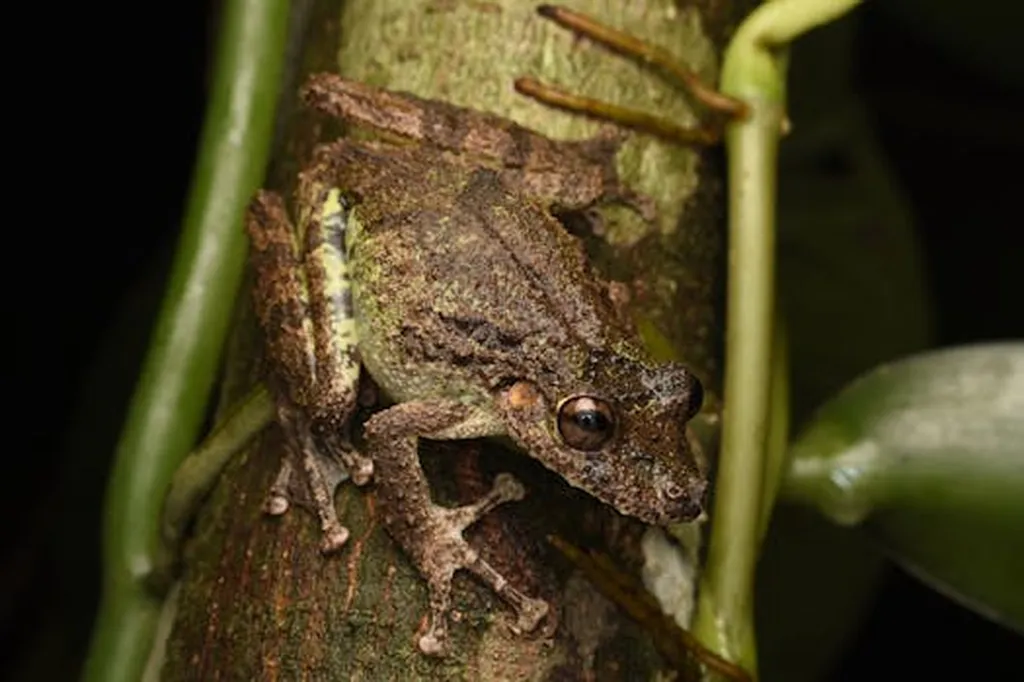In the dense forests of South Korea, a subtle ecological dance is taking place among three species of anurans—frogs and toads—that has long gone unnoticed. A recent study published in *Scientific Reports* (translated as “Nature Communications” in English) sheds light on this intricate ballet of survival, revealing how these amphibians carve out their niches in a shared habitat. The research, led by Su–Yeon Lee from the Department of Agriculture, Forestry and Bioresources at Seoul National University, uses stable isotope analysis to unravel the complex web of resource partitioning among Bombina orientalis, Rana uenoi, and Rana huanrenensis.
Stable isotope analysis (SIA) is a powerful tool that allows scientists to peek into the dietary habits and trophic levels of organisms by analyzing the ratios of certain isotopes in their tissues. In this case, Lee and her team focused on carbon (δ¹³C) and nitrogen (δ¹⁵N) isotopes in the bone collagen of the three anuran species. “By looking at these isotopes, we can infer the types of resources each species is utilizing and how they are positioned in the food web,” Lee explains.
The findings paint a vivid picture of coexistence and competition. Rana uenoi and R. huanrenensis, it turns out, are dietary generalists with a broad overlap in their isotopic niches, suggesting they share similar trophic roles. “This high overlap indicates that these two species likely compete for similar resources,” Lee notes. However, Bombina orientalis stands out with a distinct trophic niche, marked by a relative enrichment of δ¹⁵N. This suggests that B. orientalis occupies a different position in the food web, although its resource utilization is not entirely segregated from that of the two Rana species.
One of the most intriguing findings is the variation in resource use within populations. Large groups of both Rana species tend to exploit a wider variety of resources than smaller ones, a phenomenon that could be linked to their social structure or foraging strategies. In contrast, B. orientalis shows no isotopic sex differences, hinting at a more uniform resource use among its members.
The study also reveals ontogenetic niche shifts—changes in dietary habits as the animals grow. As B. orientalis matures, it increasingly relies on aquatic-origin resources, while the two Rana species shift toward terrestrial-origin resources. “These shifts are crucial for understanding how these species adapt to their environment and coexist with one another,” Lee explains.
So, what does this mean for the broader field of ecology and conservation? Understanding the trophic dynamics of forest-dwelling anurans can provide valuable insights into the health and stability of forest ecosystems. “This research serves as a baseline for future ecological and conservation studies,” Lee says. “It highlights the importance of resource partitioning and ontogenetic niche shifts in maintaining biodiversity.”
Moreover, the findings could have implications for the energy sector, particularly in areas where forest ecosystems are impacted by energy infrastructure development. By understanding the trophic structure of these ecosystems, energy companies can better assess and mitigate their environmental impacts. “This research underscores the need for a nuanced understanding of ecological interactions,” Lee concludes. “It’s a step towards more informed and sustainable management of our natural resources.”
As we delve deeper into the intricate web of life, studies like this one remind us of the delicate balance that sustains our ecosystems. They also highlight the importance of interdisciplinary research in addressing the complex challenges of conservation and sustainable development. In the words of Su–Yeon Lee, “Every species, no matter how small, plays a crucial role in the grand tapestry of life. Understanding these roles is key to preserving the biodiversity that makes our planet thrive.”

